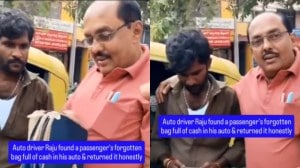Road to 2024: Karnataka done, why Congress is more hopeful for MP, Chhattisgarh, Rajasthan
Several parallels between Karnataka and coming state polls, including strong local units, clarity over chain of command, and early unveiling of welfare schemes
 After the Karnataka win, the Congress believes it has a roadmap it can replicate. (File Photo)
After the Karnataka win, the Congress believes it has a roadmap it can replicate. (File Photo) No two elections are the same. The shape and nature of the contest, the context, the ground situation, the protagonists all vary. That statutory warning aside, the Congress will surely want to carry the euphoria and momentum of its emphatic victory in Karnataka into the next round of Assembly elections, even as the BJP is expected to begin its poll efforts early to counter a Congress surge.
That means the coming Assembly elections in Madhya Pradesh, Chhattisgarh and Rajasthan are set to be a fascinating political contest. The Congress, as also the larger Opposition, will have much at stake.
While Assembly elections are, of course, different from parliamentary polls as there are more variables at play, winning more and more states is crucial for the Opposition to hold off the BJP. Besides, greater numbers in states can tilt the scales in the Rajya Sabha in favour of the Opposition.
Of the three coming elections, the Congress believes it is on a better wicket in at least two – Madhya Pradesh and Chhattisgarh – being already over the hump as far as clarity of leadership in the states goes.
After Karnataka, where too there was more or less a clear leadership template in place, the Congress believes it has a roadmap it can replicate from there in the two states in terms of electoral strategies, messaging and mobilisation – such as announcing welfare / populist sops months before elections, and keeping the campaign hyper local (in other words, ensuring Narendra Modi does not enter the equation).
There also seems to be more clarity as far as choosing its battles goes. In both the recent states the Congress won, Himachal Pradesh and Karnataka, the party was confident of a win and did everything it could to ensure that.
In comparison, the Congress campaign was more insipid in Gujarat, Tripura and Meghalaya, where it started with a disadvantage.
When it comes to Madhya Pradesh and Chhattisgarh, the Congress has a similar confidence regarding its chances. With enough push, it believes it can also swing Rajasthan – where it has an equally strong organisational presence and leadership depth.
That would deliver the Congress a significant chunk of the all-important Hindi heartland. Leave out Uttar Pradesh, and the party is also in the ruling coalition in Bihar.
Madhya Pradesh
For the first time in years, there is only one, clear-cut CM face in the Congress in the state. Arguably self-anointed, Kamal Nath has no rivals either at the top or in the ranks, and he has used the time since his rude toppling from power in 2021 to bolster his support.
Ironically, while the 2021 defection removed him as CM – the Congress took power after the 2018 Assembly elections – it meant that the only hurdle in Kamal Nath’s path, Jyotiraditya Scindia, is now gone.
Freed of the debilitating internal power struggles, Nath, the state Congress president, has been touring Madhya Pradesh, setting up a narrative against the Shivraj Singh Chouhan government, and keeping the focus on the long-time MP CM and local issues. Not quite different from how the Congress mounted its campaign in Karnataka.
Again, as it did in Himachal and Karnataka, the party has also started announcing populist sops already, well ahead of elections, to build a recall value among people when it comes time to vote – among them a Nari Samman Yojana, promising Rs 1,500 to women and a domestic gas cylinder for Rs 500 if voted to power.
Given the deep roots of Hindutva in the heartland state, Kamal Nath has not shied away either from underlining his claim to the faith – and not subtly like the Congress did in Karnataka, by bracketing the Bajrang Dal and Popular Front of India together as radical outfits needing checks.
In the 2018 elections, when it finished ahead of the BJP in Madhya Pradesh, the Congress manifesto had promised to develop a ‘Ram Van Gaman Path’, the route believed to have taken by Lord Ram during his exile, opening of a spiritual department, building of gaushalas in every panchayat and starting the commercial production of “gau mutra (cow urine)”.
This time, Kamal Nath has taken measures such as asking cadres to celebrate Ram Navmi and Hanuman Jayanti, and recite Sundarkand (a part of the Ramayana) and Hanuman Chalisa.
Chhattisgarh
He might have become CM at the head of a Congress government in 2018 after fighting off two equally strong contenders, T S Singh Deo and Tamradhwaj Sahu, but now Bhupesh Baghel is way ahead of the others.
Singh Deo might make some voices of dissent now and then, but few expect the party to dislodge Baghel, especially due to his growing proximity to the Gandhis.
The cloud over the horizon for Baghel is the “corruption” cases against him, with the Enforcement Director breathing down his neck for some time.
The BJP is expected to aggressively target the government on these issues, but in the absence of a popular face in the state, it remains to be seen how far it manages to turn these cases into some sort of an anti-incumbency mood.
Baghel, meanwhile, is counting on a slew of welfare schemes and his invocation of the Chhattisgarhi pride to override this.
Plus, the Chhattisgarh CM also flirts with political Hinduism, being among the Congress leaders who believe that the party should not shy away from celebrating Hindu festivals. It is vital to take the Hindutva plank from the BJP, Baghel feels.
Developing tourism circuit ‘Ram, Van Gaman Paryatan Paripath’, along the route that Ram is believed to have traversed in Chhattisgarh during exile, schemes like Manas Mandali Protsahan Yojana, decision to erect eight statues of Ram across the state and Godhan Nyay Yojana, are all part of Baghel’s calibrated strategy in that direction.
Rajasthan
Unlike Madhya Pradesh and Chhattisgarh, the Congress is a house divided in Rajasthan. But, to the Congress’s advantage, so is the BJP.
On the Congress side, the recurring tussle between Chief Minister Ashok Gehlot and Sachin Pilot refuses to die down, and might be entering a fresh low with Pilot’s ultimatum on Monday.
With the feud threatening to overshadowing his government’s functioning, Gehlot announced a slew of welfare schemes in his last budget earlier this year, including LPG cylinders at Rs 500 each to nearly 76 lakh families, free electricity up to 100 units per month for over 4 lakh of the state’s 1.19 crore consumers, free food packets covering about 1 crore families, and increasing the insurance cover under Chiranjeevi Health Scheme from Rs 10 lakh per family to Rs 25 lakh.
However, Pilot’s latest threat against the Gehlot government threatens to be bad optics, which could blow up any time. Sources said the party leadership is aware of this, and will be be taking the situation in hand once government formation is over in Karnataka.
And no, rather than letting the situation linger, the party will reinforce that replacing Gehlot just months to go before the next elections was not on the table. Sources said Pilot too is resigned to the fact, and is only looking for some indulgence from the high command.
- 01
- 02
- 03
- 04
- 05































